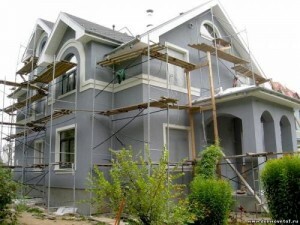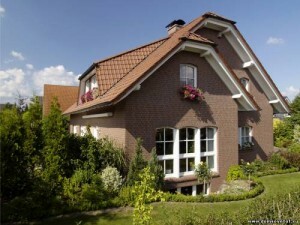How to decorate the facade of a house: choose materials
Table of contents
- 1 The façade plaster
- 2 finishing with stone
- 3 finishing thermopanels
-
4 Ventilated facade
- 4.1 Specificity ventfasada
- 4.2 The choice of cladding
- 5 Siding
- 6 wet facade
- 7 Summing up
Everyone knows that to build a house - only half the battle, it is also necessary to "dress". When "clothing" (exterior finishing materials) must show good taste and practicality. So, how to decorate the facade of the house - a question that we asked experts.
There are many options for facades, and therefore ways of decorating can be a lot.
 Modern building production provides many options for facades: stone thermal panels, siding, stucco.
Modern building production provides many options for facades: stone thermal panels, siding, stucco.
The façade plaster
Today plaster grid facade enjoys high popularity. Construction segment offers sand-cement and a variety of decorative plaster, is capable of applying to the wall a variety of patterns and textures.
Plaster can create smooth or embossed surface of the facade wall. It is important to know that the plastered walls increase the fire resistance of the building, improve its thermal and sound insulation.
The most common types of plaster are today - Cement-sand, facade (silicone, acrylic) and ornamental (mosaic, "under the coat" and others).
Plaster cement-sand comprises sand, cement and chemical additives. It is used on surfaces which are constantly exposed to high and low temperatures as well as on the walls of residing in high humidity conditions.
Acrylic - the most affordable type of decorative plaster - it allows your hands to create a durable coating on the basis of polystyrene.
The disadvantage is the lack of acrylic plaster elasticity, even insignificant temperature gradients on the surface microcracks appear.
Silicone plaster is made of silicone resin and is a polymeric coating. It is waterproof, water repellent and does not accumulate moisture, resistant to UV radiation, temperature differences are not afraid of it, it has a long service life.
The main feature of the plaster is that it mimics the more expensive types of finishes. This effect is achieved by the addition of the silica sand, pigments, stone or granite chips of various sizes.
As for the colors used to paint the plaster, you must know that for unfavorable (including severe) weather conditions and industrial areas is better to choose acrylic paints. They are more resistant to various climatic influences, quickly dry, and can provide a durable coating with good water vapor permeability.
finishing with stone

The façade facing stone
Stone - the most reliable and sturdy material, its longevity can only envy. For the decoration of the facade using both natural and artificial stone, which is often on the quality and appearance is not inferior to the natural.
Texture, color, size and breed of facing stones are determined by the architectural tasks. For example, the building, lined with diorite and granite, is more strict and monumental than the building, marble and traverinom.
Natural stone provide durability, strength and resistance to climatic influences. When choosing important to pay attention to frost-resistant properties of the stone, as this factor plays a key role in the harsh climate.
Artificial stone has a more reasonable price, but not inferior in range of colors, textures and shapes. In addition, it is light, corrosion and abrasion resistant.
finishing thermopanels

facade cladding thermopanels
Thermal panels are almost completely finished facade, which has many advantages.
First, they use a high-density expanded polystyrene - the best thermal insulator, which keeps cool in the summer and in the winter does not produce heat.
Second, the thermal panels are lightweight, so they are used for buildings with a light foundation and floors.
Thirdly, despite its low weight, they have high levels of strength.
And, fourthly, thermal panels - an environmentally friendly material based on polyurethane and ceramic tiles.
Mounting thermopanels by means of screws or dowels, which allows them to establish virtually any surface (concrete, brick or wood).
Another advantage is the fact that they are fairly easy to install and can be installed at any time of the year.
The most popular are the thermal panels with ceramic tiles "Brick" that mimic the masonry, but, interestingly, significantly surpassing its technical characteristics.
Ventilated facade
Specificity ventfasada
Ventilated facade - a kind of "layer cake", in which the insulation between the outer walls and facing material is air space. In other words, the mounted structure, which is installed at a certain distance from the wall.

Ventilated facade
Note! It allows the walls to pass air, and the excess moisture is removed in a vent zone, where it is output to the outside updrafts.
The choice of cladding
As for ventilated façade cladding can be used various materials: from lightweight aluminum composite sheet to a heavy granite slab. Such elevations have a very high energy-saving properties, and may provide excellent sound and noise insulation wall.
The main advantage of ventilated facades is that the pre-treatment of the walls is not required to have, in addition, attachments can close any defects and irregularities of the walls.
Siding

Facing the house vinyl siding (price - from 198 rubles).
One of the most frequently used options in modern decoration is finishing the house siding with their own hands. Translated from the "siding" means "skin" of the English language.
What are the different types of siding and how to decorate the house siding?
Siding can be a basement, vinyl, wood and metal.
- Ground siding used mainly for finishing the basement of the building. Install the panel thickness exceeding 3 mm simulating natural building materials (brick, facing brick).
- Ground siding - strong material, which ensures a long service life, protect the socket from external influencing factors and hides, and surface defects.
- Traditional vinyl siding is made from polyvinyl chloride (PVC), which is very endures all mechanical damage. The main disadvantage of vinyl siding is its increased sensitivity to UV light. Therefore, when choosing siding often try to avoid bright saturated colors, preferring pastel tones.
- Wood siding is the most expensive kind as is used for its manufacturing natural wood. Wooden siding - an environmentally friendly and aesthetically pleasing material, but, unfortunately, short-term.
- Metal siding - a very durable and resistant to external factors material. They often veneer farm buildings or industrial buildings.
wet facade

Facing the "wet facade"
This technology is a multilayer structure of the facade, each of which performs certain functions.
The standard system is a "wet facade" consists of three layers reinforced (base), and an outer insulating (decorative) layer.
- Reinforced layer ensures evenness of the outer wall and fixes the thermal insulating material. It consists of reinforced mesh and adhesive.
- The thermal insulation layer consists of insulating plates having a low thermal conductivity. Typically such slabs made of mineral wool or expanded polystyrene.
- The decorative layer is made of plaster (silicone or mineral) and simultaneously performs two functions - a decorative and protective.
The answer to the question of how to decorate the facade of the house depends on many factors, among which recently took the financial side and personal preferences.
Summing up
We hope our article has been helpful to you. In order to more accurately understand the technological and practical issues on our website provides detailed photo and video instruction, in which you will find useful information on the question.


